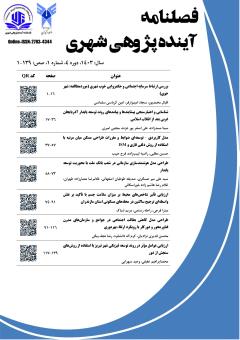طراحی مدل کاهش بطالت اجتماعی در جوامع و سازمانهای مدرن فناورمحور و دورکار با رویکرد ارتقاء بهرهوری
محورهای موضوعی : فصلنامه آینده پژوهی شهری
کرم اله دانشفرد
1
*
![]() ,
رضا نجف بیگی
2
,
محسن قدیری نژادیان
3
,
رضا نجف بیگی
2
,
محسن قدیری نژادیان
3
![]()
1 - استاد گروه مدیریت دولتی، دانشگاه آزاد اسلامی، واحد علوم و تحقیقات، تهران، ایران
2 - استاد گروه مدیریت دولتی، دانشگاه آزاد اسلامی، واحد علوم و تحقیقات، تهران، ایران
3 - دانشجوی دکتری رشته مدیریت دولتی گرایش رفتار سازمانی، دانشگاه آزاد اسلامی واحد علوم و تحقیقات، تهران، ایران
کلید واژه: بطالت اجتماعی, بهرهوری, سازمان فناورمحور, دورکاری.,
چکیده مقاله :
این پژوهش با هدف بررسی ابعاد، مؤلفهها و شاخصهای بطالت اجتماعی و درنهایت صحت معیارهای شناساییشده در قالب تبیین مدلی اکتشافی برای کاهش بطالت اجتماعی در سازمانهای فناورمحور و مانوس با دورکاری همراستا با ارتقاء بهرهوری انجام شد. این پژوهش از منظر نوع توصیفی و از منظر روششناسی کاربردی محسوب میگردد و با استفاده از روش آمیخته (کیفی-کمی) به انجام رسید که استخراج 5 بعد اصلی از 16 مؤلفه و 51 شاخص در بخش کیفی با استفاده از تحلیل محتوا مصاحبه با 20 نفر از خبرگان دانشگاهی و سازمانی در حوزه بطالت اجتماعی صورت گرفت و برای دستیابی به الگو در بخش کمی از روش مدلسازی ساختاری تفسیری (ISM) و مضافاً پرسشنامه استفاده شد. پژوهش حاضر به لحاظ زمانی در مقطع 18 ماهه تدوین شد و به تحلیل دادههای کمی و کیفی پرداخت. جامعه آماری در بخش کمی، کارشناسان ارشد شرکت خدمات انفورماتیک بازوی فناوری الکترونیک بانک مرکزی بودند. در تجزیهوتحلیل دادههای کیفی از نرمافزار Maxqda و در تجزیهوتحلیل دادههای بخش کمی حاصله از 96 پرسشنامه، از نرمافزارهای SPSS و PLS و تحلیل مسیر، رگرسیون و معادلات ساختاری استفاده شد. تحلیل دادههای کیفی و کمی پژوهش دستیابی به 5 بعد سازمانی، رفتاری، نظامهای مدیریتی، فرهنگی و اهداف /استراتژی بود که طی تحلیلهای صورت گرفته متغیر سازمانی به عنوان متغیر مستقل، متغیر اهداف / استراتژی بهعنوان متغیر وابسته، متغیر نظامهای مدیریتی بهعنوان متغیر میانجی و درنهایت متغیرهای رفتاری و فرهنگی بهعنوان متغیرهای رابط شناسایی شدند. مدل حاصله از تحلیل ISM و استفاده از تحلیل میک مک نیز منتج به ارائه مدلی 3 سطحی بود که بعد سازمان تأثیرگذارترین و بعد اهداف / استراتژی بهعنوان تأثیرپذیرترین بعد شناخته شد. بهرهگیری از نتایج مدل اکتشافی این پژوهش میتواند بهصورت عملی منتج به کاهش بطالت اجتماعی در سازمانهای فناورمحور و متأثر از سازوکارهای دورکاری شده و درعینحال ارتقاء بهرهوری در این سازمانها را به همراه داشته باشد.
This research was conducted with the aim of investigating the dimensions, components and indicators of social loafing, and finally, the accuracy of the identified criteria in the form of explaining an exploratory model to reduce social loafing in technology-oriented organizations familiar with remote working, in line with improving productivity. This research is considered descriptive from the point of view of applied methodology, and Was done using a mixed method (qualitative-quantitative), extracting 5 main dimensions from 16 components and 51 indicatorsIn the qualitative section, using content analysis and interviews with 20 academic and organizational experts in the field of social loafing, the data was collected. To obtain the model in the quantitative part, the Interpretive Structural Modeling (ISM) method and a questionnaire were used. The current research spanned 18 months and involved the analysis of quantitative and qualitative data. The statistical population in the quantitative part comprised senior experts from the Informatics Services Company, the electronic technology arm of the Central Bank of Iran. Maxqda software was used to analyze the qualitative data, and SPSS and PLS software, along with path analysis, regression, and structural equations, were used to analyze the quantitative data obtained from 96 questionnaires. The qualitative and quantitative data analysis of the research identified 5 dimensions: organization, behavior, management systems, culture, and goals/strategy. Behavioral and cultural variables were identified as mediator variables. The model resulting from the ISM analysis and the use of the Mic-Mac analysis presented a 3-level model, in which the organization dimension was the most influential, and the goals/strategy dimension was recognized as the most influential dimension. Taking advantage of the results of the exploratory model of this research can practically lead to the reduction of social loafing in technology-oriented organizations affected by remote work mechanisms, and at the same time, it can increase productivity in these organizations.

